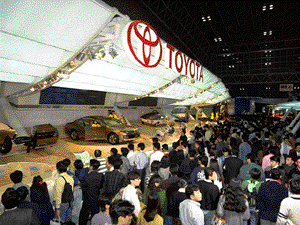 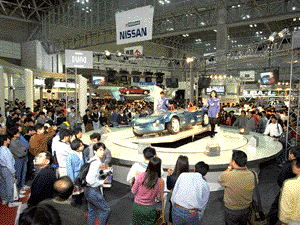
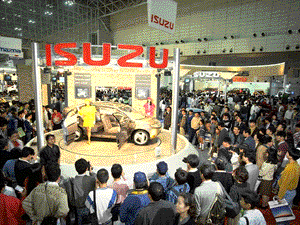
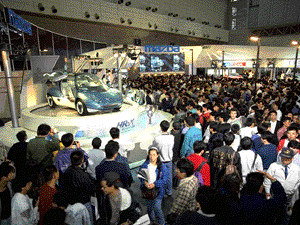
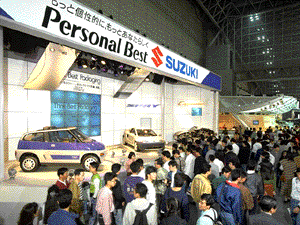
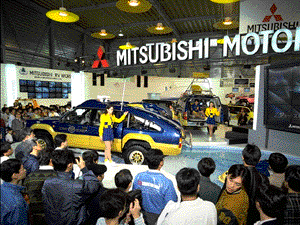
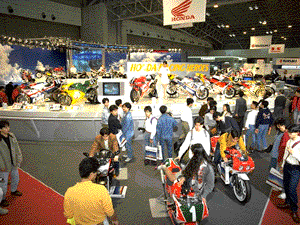
|
"Discovering a New Relationship: People, Cars and Earth as One"
The auto industry was facing a difficult year. Key words describing
business issues in the 1990s were: international cooperation, environment, traffic safety and kyosei. These problems became important for survival into the 21st century as the environment surrounding the auto industry changed dramatically.
International cooperation: Seven auto companies started production in the U.S. to prevent the revival of Japan-U.S. trade friction, restrain Japanese auto exports, and cooperate in the revitalization of the U.S. economy. Their contribution to the U.S. economy was shown by their production of 1.55 million vehicles and the employment of 30,000 people in 1991. However, friction did resurface again, because 1990 statistics showed automobile (including parts) exports reaching 36% of total Japanese exports to the U.S. Hence, the Japanese auto industry became the target of attack by the U.S. Record-poor business prospects for GM, Ford and Chrysler was also a reason. To avoid this friction, Japan made efforts in line with Japan-U.S. discussions. These were (1) expansion of parts imports (from $7 billion in 1990 to $19 billion in 1994), (2) expansion of car imports (with Japanese auto dealers cooperating in sell in the cars), and (3) alleviation of imported car standards and certification requirements.
Environment: Global warming became the greatest problem of human society, and automobiles came to bear part of the responsibility. Japan s energy-saving technology set the world standard. However, pursuit of higher economic growth inevitably leads to increased energy consumption, which, in turn, increases emissions of CO2 that are considered to be the greatest cause of global warming. To reduce CO2 emissions, development of energy-saving technology and social systems (eliminating traffic congestion, etc.) became all the more important. Automakers had to not only clear pollution regulations, but work to maintain the environment.
Traffic safety: Traffic accident victims in 1990 exceeded 10,000 line for third consecutive year, and vehicle safety measures drew greater
attention after the government declared a "Traffic Accident Emergency." As more people became concerned about "the second traffic war" and becoming a "car-dependent society," criticisms of vehicles that prevailed in the 1970s seemed to return.
Against this background, society s evaluation of companies changed. "How it contributes to society" came to be regarded as more important than "how much profit it makes." One after another company set up community relations departments.
Changes in the auto industry environment began affecting other businesses gradually. Domestic automobile sales started to decline. As the Japan Automobile Manufacturers Association, Inc. (JAMA) modified its demand forecast to 7.67 million units, an annual decrease of 1.6% rather than its
original forecast of minus 1.0%, prospect were very dull.
An unprecedented 352 companies, two governments and one organization representing 13 countries participated in the Show. Despite the unfavorable environment of recession and sluggish auto sales, admissions totaled 2,018,500,an all-time record. The Tokyo Motor Show marked the world record for the second show in a row as far as admissions were concerned. This may be partly owing to JMIF s efforts to expand exhibition space and PR activities aimed at attracting as many visitors as the previous show (1.92 million). Most amazing was the number of people who seek fantasy through cars. Enthusiasm filled the show, and must have given everyone confidence that Japan s future motorization would be bright. There were many top managers of American and European automakers visiting the show. To name a few, Mr. Lloyd E. Reuss, President of GM, Mr. Philip Bent, President of Ford, and Mr. Michael Farren, U.S. Under Secretary of International Trade Administration. From Europe Mr. Umberto Agnelli, Vice Chairman of Fiat, Mr. Jacques Calvet, Chairman of the Peugeot Group, Mr. Werner Niefer, President of Mercedes Benz, and so on. Active inter-national exchange at the Tokyo Motor Show was impressive. The gathering of world-renowned VIPs attracted more press people from Japan and abroad than the previous show. A total of 10,674 (35% more than the 28th show) included 8,861 domestic (32% more) and 1,813 overseas (52% more). All were record numbers. Particularly, this show drew media from developing countries, which highlighted the increased worldwide interest in the Tokyo Motor Show.
Amid calls for environmental protection and prevention of traffic
accidents, the auto industry got into high gear to produce vehicles "friendly to the earth and man." The salient characteristic of this show was competitive display of technologies under development. The same trend was seen in exhibitions by foreign automakers. For environmental protection, efforts to reduce fuel consumption by existing engines were seen, and new engines such as lean-burning and twin-cycles came into bloom. However, the newest technology of each company seemed to be directed to alternative energy vehicles. Most conspicuous were: the TRI-X (Nissan) powered by a gasoline-methanol mix; the Ryoma (Fuji Heavy Industries); the HR-X (Mazda), a hydrogen-fueled rotary-engine car; and solar cars (Toyota and Honda). Although they were still only dream cars, the Mazda HR-X was said to be feasible within this century and drew attention. Realized dream cars were electric vehicles (EV). A prototype exhibited by Tokyo Electric Power Co. could run 548 km on one charge. Maximum speed was 176 km per hour, the best performance in the world.
|